Plotting¶
We use the standard convention for referencing the matplotlib API:
In [1]: import matplotlib.pyplot as plt
New in version 0.11.0.
The display.mpl_style produces more appealing plots. When set, matplotlib’s rcParams are changed (globally!) to nicer-looking settings. All the plots in the documentation are rendered with this option set to the ‘default’ style.
In [2]: pd.options.display.mpl_style = 'default'
We provide the basics in pandas to easily create decent looking plots. See the ecosystem section for visualization libraries that go beyond the basics documented here.
Note
All calls to np.random are seeded with 123456.
Basic Plotting: plot¶
See the cookbook for some advanced strategies
The plot method on Series and DataFrame is just a simple wrapper around plt.plot():
In [3]: ts = Series(randn(1000), index=date_range('1/1/2000', periods=1000))
In [4]: ts = ts.cumsum()
In [5]: ts.plot()
Out[5]: <matplotlib.axes.AxesSubplot at 0xa19b1dac>

If the index consists of dates, it calls gcf().autofmt_xdate() to try to format the x-axis nicely as per above.
On DataFrame, plot() is a convenience to plot all of the columns with labels:
In [6]: df = DataFrame(randn(1000, 4), index=ts.index, columns=list('ABCD'))
In [7]: df = df.cumsum()
In [8]: plt.figure(); df.plot();

You can plot one column versus another using the x and y keywords in plot():
In [9]: df3 = DataFrame(randn(1000, 2), columns=['B', 'C']).cumsum()
In [10]: df3['A'] = Series(list(range(len(df))))
In [11]: df3.plot(x='A', y='B')
Out[11]: <matplotlib.axes.AxesSubplot at 0xa1c2e84c>

Note
For more formatting and sytling options, see below.
Other Plots¶
The kind keyword argument of plot() accepts a handful of values for plots other than the default Line plot. These include:
- ‘bar’ or ‘barh’ for bar plots
- ‘kde’ or 'density' for density plots
- ‘area’ for area plots
- ‘scatter’ for scatter plots
- ‘hexbin’ for hexagonal bin plots
- ‘pie’ for pie plots
In addition to these kind s, there are the DataFrame.hist(), and DataFrame.boxplot() methods, which use a separate interface.
Finally, there are several plotting functions in pandas.tools.plotting that take a Series or DataFrame as an argument. These include
- Scatter Matrix
- Andrews Curves
- Parallel Coordinates
- Lag Plot
- Autocorrelation Plot
- Bootstrap Plot
- RadViz
Plots may also be adorned with errorbars or tables.
Bar plots¶
For labeled, non-time series data, you may wish to produce a bar plot:
In [12]: plt.figure();
In [13]: df.ix[5].plot(kind='bar'); plt.axhline(0, color='k')
Out[13]: <matplotlib.lines.Line2D at 0xa1b7008c>

Calling a DataFrame’s plot() method with kind='bar' produces a multiple bar plot:
In [14]: df2 = DataFrame(rand(10, 4), columns=['a', 'b', 'c', 'd'])
In [15]: df2.plot(kind='bar');

To produce a stacked bar plot, pass stacked=True:
In [16]: df2.plot(kind='bar', stacked=True);

To get horizontal bar plots, pass kind='barh':
In [17]: df2.plot(kind='barh', stacked=True);

Histograms¶
In [18]: plt.figure();
In [19]: df['A'].diff().hist()
Out[19]: <matplotlib.axes.AxesSubplot at 0xa1aedd4c>

DataFrame.hist() plots the histograms of the columns on multiple subplots:
In [20]: plt.figure()
Out[20]: <matplotlib.figure.Figure at 0xa11124ec>
In [21]: df.diff().hist(color='k', alpha=0.5, bins=50)
Out[21]:
array([[<matplotlib.axes.AxesSubplot object at 0xa14e8d4c>,
<matplotlib.axes.AxesSubplot object at 0xa112d9cc>],
[<matplotlib.axes.AxesSubplot object at 0xa1127c2c>,
<matplotlib.axes.AxesSubplot object at 0xa5e286cc>]], dtype=object)
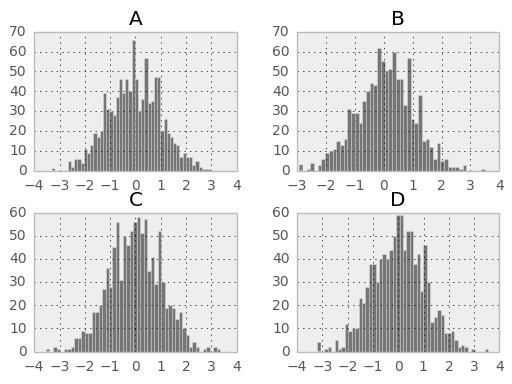
New in version 0.10.0.
The by keyword can be specified to plot grouped histograms:
In [22]: data = Series(randn(1000))
In [23]: data.hist(by=randint(0, 4, 1000), figsize=(6, 4))
Out[23]:
array([[<matplotlib.axes.AxesSubplot object at 0xa0f524cc>,
<matplotlib.axes.AxesSubplot object at 0xa0c7376c>],
[<matplotlib.axes.AxesSubplot object at 0xa5eb15cc>,
<matplotlib.axes.AxesSubplot object at 0xa99ec4cc>]], dtype=object)

Box Plots¶
DataFrame has a boxplot() method that allows you to visualize the distribution of values within each column.
For instance, here is a boxplot representing five trials of 10 observations of a uniform random variable on [0,1).
In [24]: df = DataFrame(rand(10,5))
In [25]: plt.figure();
In [26]: bp = df.boxplot()

You can create a stratified boxplot using the by keyword argument to create groupings. For instance,
In [27]: df = DataFrame(rand(10,2), columns=['Col1', 'Col2'] )
In [28]: df['X'] = Series(['A','A','A','A','A','B','B','B','B','B'])
In [29]: plt.figure();
In [30]: bp = df.boxplot(by='X')

You can also pass a subset of columns to plot, as well as group by multiple columns:
In [31]: df = DataFrame(rand(10,3), columns=['Col1', 'Col2', 'Col3'])
In [32]: df['X'] = Series(['A','A','A','A','A','B','B','B','B','B'])
In [33]: df['Y'] = Series(['A','B','A','B','A','B','A','B','A','B'])
In [34]: plt.figure();
In [35]: bp = df.boxplot(column=['Col1','Col2'], by=['X','Y'])

The return type of boxplot depends on two keyword arguments: by and return_type. When by is None:
- if return_type is 'dict', a dictionary containing the matplotlib Lines is returned. The keys are “boxes”, “caps”, “fliers”, “medians”, and “whiskers”.
This is the deafult.
if return_type is 'axes', a matplotlib Axes containing the boxplot is returned.
- if return_type is 'both' a namedtuple containging the matplotlib Axes
and matplotlib Lines is returned
When by is some column of the DataFrame, a dict of return_type is returned, where the keys are the columns of the DataFrame. The plot has a facet for each column of the DataFrame, with a separate box for each value of by.
Finally, when calling boxplot on a Groupby object, a dict of return_type is returned, where the keys are the same as the Groupby object. The plot has a facet for each key, with each facet containing a box for each column of the DataFrame.
In [36]: np.random.seed(1234)
In [37]: df_box = DataFrame(np.random.randn(50, 2))
In [38]: df_box['g'] = np.random.choice(['A', 'B'], size=50)
In [39]: df_box.loc[df_box['g'] == 'B', 1] += 3
In [40]: bp = df_box.boxplot(by='g')

Compare to:
In [41]: bp = df_box.groupby('g').boxplot()
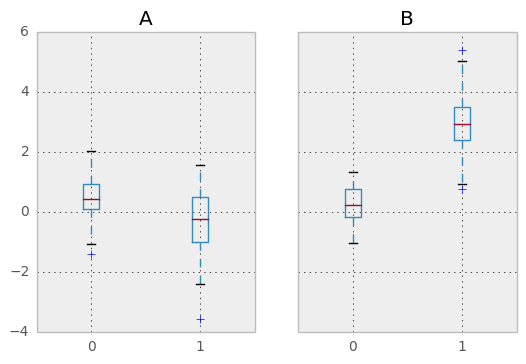
Area Plot¶
New in version 0.14.
You can create area plots with Series.plot and DataFrame.plot by passing kind='area'. Area plots are stacked by default. To produce stacked area plot, each column must be either all positive or all negative values.
When input data contains NaN, it will be automatically filled by 0. If you want to drop or fill by different values, use dataframe.dropna() or dataframe.fillna() before calling plot.
In [42]: df = DataFrame(rand(10, 4), columns=['a', 'b', 'c', 'd'])
In [43]: df.plot(kind='area');

To produce an unstacked plot, pass stacked=False. Alpha value is set to 0.5 unless otherwise specified:
In [44]: df.plot(kind='area', stacked=False);

Hexagonal Bin Plot¶
New in version 0.14.
You can create hexagonal bin plots with DataFrame.plot() and kind='hexbin'. Hexbin plots can be a useful alternative to scatter plots if your data are too dense to plot each point individually.
In [45]: df = DataFrame(randn(1000, 2), columns=['a', 'b'])
In [46]: df['b'] = df['b'] + np.arange(1000)
In [47]: df.plot(kind='hexbin', x='a', y='b', gridsize=25)
Out[47]: <matplotlib.axes.AxesSubplot at 0xa111a4cc>

A useful keyword argument is gridsize; it controls the number of hexagons in the x-direction, and defaults to 100. A larger gridsize means more, smaller bins.
By default, a histogram of the counts around each (x, y) point is computed. You can specify alternative aggregations by passing values to the C and reduce_C_function arguments. C specifies the value at each (x, y) point and reduce_C_function is a function of one argument that reduces all the values in a bin to a single number (e.g. mean, max, sum, std). In this example the positions are given by columns a and b, while the value is given by column z. The bins are aggregated with numpy’s max function.
In [48]: df = DataFrame(randn(1000, 2), columns=['a', 'b'])
In [49]: df['b'] = df['b'] = df['b'] + np.arange(1000)
In [50]: df['z'] = np.random.uniform(0, 3, 1000)
In [51]: df.plot(kind='hexbin', x='a', y='b', C='z', reduce_C_function=np.max,
....: gridsize=25)
....:
Out[51]: <matplotlib.axes.AxesSubplot at 0xa0b0f12c>

See the hexbin method and the matplotlib hexbin documenation for more.
Pie plot¶
New in version 0.14.
You can create a pie plot with DataFrame.plot() or Series.plot() with kind='pie'. If your data includes any NaN, they will be automatically filled with 0. A ValueError will be raised if there are any negative values in your data.
In [52]: series = Series(3 * rand(4), index=['a', 'b', 'c', 'd'], name='series')
In [53]: series.plot(kind='pie')
Out[53]: <matplotlib.axes.AxesSubplot at 0xa07bf2ac>

Note that pie plot with DataFrame requires that you either specify a target column by the y argument or subplots=True. When y is specified, pie plot of selected column will be drawn. If subplots=True is specified, pie plots for each column are drawn as subplots. A legend will be drawn in each pie plots by default; specify legend=False to hide it.
In [54]: df = DataFrame(3 * rand(4, 2), index=['a', 'b', 'c', 'd'], columns=['x', 'y'])
In [55]: df.plot(kind='pie', subplots=True)
Out[55]:
array([<matplotlib.axes.AxesSubplot object at 0xa0723bac>,
<matplotlib.axes.AxesSubplot object at 0xa06ea04c>], dtype=object)

You can use the labels and colors keywords to specify the labels and colors of each wedge.
Warning
Most pandas plots use the the label and color arguments (not the lack of “s” on those). To be consistent with matplotlib.pyplot.pie() you must use labels and colors.
If you want to hide wedge labels, specify labels=None. If fontsize is specified, the value will be applied to wedge labels. Also, other keywords supported by matplotlib.pyplot.pie() can be used.
In [56]: series.plot(kind='pie', labels=['AA', 'BB', 'CC', 'DD'], colors=['r', 'g', 'b', 'c'],
....: autopct='%.2f', fontsize=20)
....:
Out[56]: <matplotlib.axes.AxesSubplot at 0xa02d6aac>

If you pass values whose sum total is less than 1.0, matplotlib draws a semicircle.
In [57]: series = Series([0.1] * 4, index=['a', 'b', 'c', 'd'], name='series2')
In [58]: series.plot(kind='pie')
Out[58]: <matplotlib.axes.AxesSubplot at 0xa022f4ec>

See the matplotlib pie documenation for more.
Plotting Tools¶
These functions can be imported from pandas.tools.plotting and take a Series or DataFrame as an argument.
Scatter Matrix Plot¶
New in version 0.7.3.
- You can create a scatter plot matrix using the
- scatter_matrix method in pandas.tools.plotting:
In [59]: from pandas.tools.plotting import scatter_matrix
In [60]: df = DataFrame(randn(1000, 4), columns=['a', 'b', 'c', 'd'])
In [61]: scatter_matrix(df, alpha=0.2, figsize=(6, 6), diagonal='kde')
Out[61]:
array([[<matplotlib.axes.AxesSubplot object at 0xa08d4f6c>,
<matplotlib.axes.AxesSubplot object at 0xa1dec96c>,
<matplotlib.axes.AxesSubplot object at 0xa152ba8c>,
<matplotlib.axes.AxesSubplot object at 0xa3501dec>],
[<matplotlib.axes.AxesSubplot object at 0xa0d2b72c>,
<matplotlib.axes.AxesSubplot object at 0xa07fddac>,
<matplotlib.axes.AxesSubplot object at 0xa0b06e2c>,
<matplotlib.axes.AxesSubplot object at 0xa0a232cc>],
[<matplotlib.axes.AxesSubplot object at 0xa0938a8c>,
<matplotlib.axes.AxesSubplot object at 0xa0b4220c>,
<matplotlib.axes.AxesSubplot object at 0xa0a37ecc>,
<matplotlib.axes.AxesSubplot object at 0xa0b575ec>],
[<matplotlib.axes.AxesSubplot object at 0xa0af930c>,
<matplotlib.axes.AxesSubplot object at 0xa083dd6c>,
<matplotlib.axes.AxesSubplot object at 0xa082924c>,
<matplotlib.axes.AxesSubplot object at 0xa18cf1ec>]], dtype=object)

Density Plot¶
New in version 0.8.0.
You can create density plots using the Series/DataFrame.plot and setting kind='kde':
In [62]: ser = Series(randn(1000))
In [63]: ser.plot(kind='kde')
Out[63]: <matplotlib.axes.AxesSubplot at 0xa063fd6c>

Andrews Curves¶
Andrews curves allow one to plot multivariate data as a large number of curves that are created using the attributes of samples as coefficients for Fourier series. By coloring these curves differently for each class it is possible to visualize data clustering. Curves belonging to samples of the same class will usually be closer together and form larger structures.
Note: The “Iris” dataset is available here.
In [64]: from pandas import read_csv
In [65]: from pandas.tools.plotting import andrews_curves
In [66]: data = read_csv('data/iris.data')
In [67]: plt.figure()
Out[67]: <matplotlib.figure.Figure at 0xa0510aac>
In [68]: andrews_curves(data, 'Name')
Out[68]: <matplotlib.axes.AxesSubplot at 0xa051090c>

Parallel Coordinates¶
Parallel coordinates is a plotting technique for plotting multivariate data. It allows one to see clusters in data and to estimate other statistics visually. Using parallel coordinates points are represented as connected line segments. Each vertical line represents one attribute. One set of connected line segments represents one data point. Points that tend to cluster will appear closer together.
In [69]: from pandas import read_csv
In [70]: from pandas.tools.plotting import parallel_coordinates
In [71]: data = read_csv('data/iris.data')
In [72]: plt.figure()
Out[72]: <matplotlib.figure.Figure at 0xa00c8e4c>
In [73]: parallel_coordinates(data, 'Name')
Out[73]: <matplotlib.axes.AxesSubplot at 0xa00c832c>

Lag Plot¶
Lag plots are used to check if a data set or time series is random. Random data should not exhibit any structure in the lag plot. Non-random structure implies that the underlying data are not random.
In [74]: from pandas.tools.plotting import lag_plot
In [75]: plt.figure()
Out[75]: <matplotlib.figure.Figure at 0x9f7eadec>
In [76]: data = Series(0.1 * rand(1000) +
....: 0.9 * np.sin(np.linspace(-99 * np.pi, 99 * np.pi, num=1000)))
....:
In [77]: lag_plot(data)
Out[77]: <matplotlib.axes.AxesSubplot at 0x9fc6d9ac>

Autocorrelation Plot¶
Autocorrelation plots are often used for checking randomness in time series. This is done by computing autocorrelations for data values at varying time lags. If time series is random, such autocorrelations should be near zero for any and all time-lag separations. If time series is non-random then one or more of the autocorrelations will be significantly non-zero. The horizontal lines displayed in the plot correspond to 95% and 99% confidence bands. The dashed line is 99% confidence band.
In [78]: from pandas.tools.plotting import autocorrelation_plot
In [79]: plt.figure()
Out[79]: <matplotlib.figure.Figure at 0x9f81ef8c>
In [80]: data = Series(0.7 * rand(1000) +
....: 0.3 * np.sin(np.linspace(-9 * np.pi, 9 * np.pi, num=1000)))
....:
In [81]: autocorrelation_plot(data)
Out[81]: <matplotlib.axes.AxesSubplot at 0x9f8d07ac>
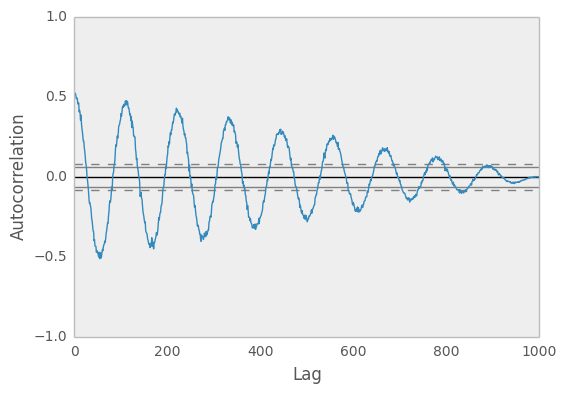
Bootstrap Plot¶
Bootstrap plots are used to visually assess the uncertainty of a statistic, such as mean, median, midrange, etc. A random subset of a specified size is selected from a data set, the statistic in question is computed for this subset and the process is repeated a specified number of times. Resulting plots and histograms are what constitutes the bootstrap plot.
In [82]: from pandas.tools.plotting import bootstrap_plot
In [83]: data = Series(rand(1000))
In [84]: bootstrap_plot(data, size=50, samples=500, color='grey')
Out[84]: <matplotlib.figure.Figure at 0x9f522eac>

RadViz¶
RadViz is a way of visualizing multi-variate data. It is based on a simple spring tension minimization algorithm. Basically you set up a bunch of points in a plane. In our case they are equally spaced on a unit circle. Each point represents a single attribute. You then pretend that each sample in the data set is attached to each of these points by a spring, the stiffness of which is proportional to the numerical value of that attribute (they are normalized to unit interval). The point in the plane, where our sample settles to (where the forces acting on our sample are at an equilibrium) is where a dot representing our sample will be drawn. Depending on which class that sample belongs it will be colored differently.
Note: The “Iris” dataset is available here.
In [85]: from pandas import read_csv
In [86]: from pandas.tools.plotting import radviz
In [87]: data = read_csv('data/iris.data')
In [88]: plt.figure()
Out[88]: <matplotlib.figure.Figure at 0x9f9dab6c>
In [89]: radviz(data, 'Name')
Out[89]: <matplotlib.axes.AxesSubplot at 0x9fab632c>

Plot Formatting¶
Most plotting methods have a set of keyword arguments that control the layout and formatting of the returned plot:
In [90]: plt.figure(); ts.plot(style='k--', label='Series');

For each kind of plot (e.g. line, bar, scatter) any additional arguments keywords are passed alogn to the corresponding matplotlib function (ax.plot(), ax.bar(), ax.scatter()). These can be used to control additional styling, beyond what pandas provides.
Controlling the Legend¶
You may set the legend argument to False to hide the legend, which is shown by default.
In [91]: df = DataFrame(randn(1000, 4), index=ts.index, columns=list('ABCD'))
In [92]: df = df.cumsum()
In [93]: df.plot(legend=False)
Out[93]: <matplotlib.axes.AxesSubplot at 0x9fe6314c>

Scales¶
You may pass logy to get a log-scale Y axis.
In [94]: ts = Series(randn(1000), index=date_range('1/1/2000', periods=1000))
In [95]: ts = np.exp(ts.cumsum())
In [96]: ts.plot(logy=True)
Out[96]: <matplotlib.axes.AxesSubplot at 0x9f866e2c>

See also the logx and loglog keyword arguments.
Plotting on a Secondary Y-axis¶
To plot data on a secondary y-axis, use the secondary_y keyword:
In [97]: df.A.plot()
Out[97]: <matplotlib.axes.AxesSubplot at 0x9f5e2b0c>
In [98]: df.B.plot(secondary_y=True, style='g')
Out[98]: <matplotlib.axes.AxesSubplot at 0x9f5b316c>

To plot some columns in a DataFrame, give the column names to the secondary_y keyword:
In [99]: plt.figure()
Out[99]: <matplotlib.figure.Figure at 0x9ee7702c>
In [100]: ax = df.plot(secondary_y=['A', 'B'])
In [101]: ax.set_ylabel('CD scale')
Out[101]: <matplotlib.text.Text at 0x9eea0cac>
In [102]: ax.right_ax.set_ylabel('AB scale')
Out[102]: <matplotlib.text.Text at 0x9f17960c>

Note that the columns plotted on the secondary y-axis is automatically marked with “(right)” in the legend. To turn off the automatic marking, use the mark_right=False keyword:
In [103]: plt.figure()
Out[103]: <matplotlib.figure.Figure at 0x9eeaa0ac>
In [104]: df.plot(secondary_y=['A', 'B'], mark_right=False)
Out[104]: <matplotlib.axes.AxesSubplot at 0x9ee8f9ec>

Suppressing Tick Resolution Adjustment¶
Pandas includes automatically tick resolution adjustment for regular frequency time-series data. For limited cases where pandas cannot infer the frequency information (e.g., in an externally created twinx), you can choose to suppress this behavior for alignment purposes.
Here is the default behavior, notice how the x-axis tick labelling is performed:
In [105]: plt.figure()
Out[105]: <matplotlib.figure.Figure at 0x9ef80bac>
In [106]: df.A.plot()
Out[106]: <matplotlib.axes.AxesSubplot at 0x9ef5b4cc>

Using the x_compat parameter, you can suppress this behavior:
In [107]: plt.figure()
Out[107]: <matplotlib.figure.Figure at 0x9ea2f50c>
In [108]: df.A.plot(x_compat=True)
Out[108]: <matplotlib.axes.AxesSubplot at 0x9ef4a40c>

If you have more than one plot that needs to be suppressed, the use method in pandas.plot_params can be used in a with statement:
In [109]: import pandas as pd
In [110]: plt.figure()
Out[110]: <matplotlib.figure.Figure at 0x9ea52d2c>
In [111]: with pd.plot_params.use('x_compat', True):
.....: df.A.plot(color='r')
.....: df.B.plot(color='g')
.....: df.C.plot(color='b')
.....:
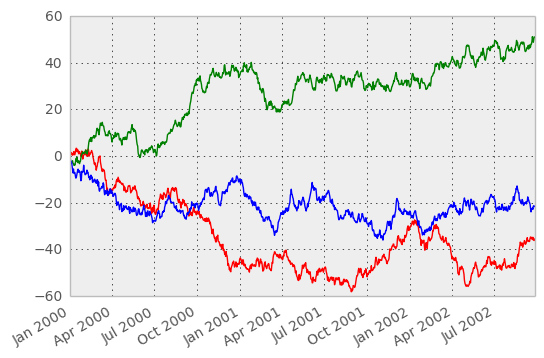
Subplots¶
Each Series in a DataFrame can be plotted on a different axis with the subplots keyword:
In [112]: df.plot(subplots=True, figsize=(6, 6));

Targeting Different Subplots¶
You can pass an ax argument to Series.plot() to plot on a particular axis:
In [113]: fig, axes = plt.subplots(nrows=2, ncols=2)
In [114]: df['A'].plot(ax=axes[0,0]); axes[0,0].set_title('A')
Out[114]: <matplotlib.text.Text at 0x9ec526ec>
In [115]: df['B'].plot(ax=axes[0,1]); axes[0,1].set_title('B')
Out[115]: <matplotlib.text.Text at 0x9e46c40c>
In [116]: df['C'].plot(ax=axes[1,0]); axes[1,0].set_title('C')
Out[116]: <matplotlib.text.Text at 0x9e697c2c>
In [117]: df['D'].plot(ax=axes[1,1]); axes[1,1].set_title('D')
Out[117]: <matplotlib.text.Text at 0x9e640dac>

Plotting With Error Bars¶
New in version 0.14.
Plotting with error bars is now supported in the DataFrame.plot() and Series.plot()
Horizontal and vertical errorbars can be supplied to the xerr and yerr keyword arguments to plot(). The error values can be specified using a variety of formats.
- As a DataFrame or dict of errors with column names matching the columns attribute of the plotting DataFrame or matching the name attribute of the Series
- As a str indicating which of the columns of plotting DataFrame contain the error values
- As raw values (list, tuple, or np.ndarray). Must be the same length as the plotting DataFrame/Series
Asymmetrical error bars are also supported, however raw error values must be provided in this case. For a M length Series, a Mx2 array should be provided indicating lower and upper (or left and right) errors. For a MxN DataFrame, asymmetrical errors should be in a Mx2xN array.
Here is an example of one way to easily plot group means with standard deviations from the raw data.
# Generate the data
In [118]: ix3 = pd.MultiIndex.from_arrays([['a', 'a', 'a', 'a', 'b', 'b', 'b', 'b'], ['foo', 'foo', 'bar', 'bar', 'foo', 'foo', 'bar', 'bar']], names=['letter', 'word'])
In [119]: df3 = pd.DataFrame({'data1': [3, 2, 4, 3, 2, 4, 3, 2], 'data2': [6, 5, 7, 5, 4, 5, 6, 5]}, index=ix3)
# Group by index labels and take the means and standard deviations for each group
In [120]: gp3 = df3.groupby(level=('letter', 'word'))
In [121]: means = gp3.mean()
In [122]: errors = gp3.std()
In [123]: means
Out[123]:
data1 data2
letter word
a bar 3.5 6.0
foo 2.5 5.5
b bar 2.5 5.5
foo 3.0 4.5
In [124]: errors
Out[124]:
data1 data2
letter word
a bar 0.707107 1.414214
foo 0.707107 0.707107
b bar 0.707107 0.707107
foo 1.414214 0.707107
# Plot
In [125]: fig, ax = plt.subplots()
In [126]: means.plot(yerr=errors, ax=ax, kind='bar')
Out[126]: <matplotlib.axes.AxesSubplot at 0x9ebc7dac>

Plotting Tables¶
New in version 0.14.
Plotting with matplotlib table is now supported in DataFrame.plot() and Series.plot() with a table keyword. The table keyword can accept bool, DataFrame or Series. The simple way to draw a table is to specify table=True. Data will be transposed to meet matplotlib’s default layout.
In [127]: fig, ax = plt.subplots(1, 1)
In [128]: df = DataFrame(rand(5, 3), columns=['a', 'b', 'c'])
In [129]: ax.get_xaxis().set_visible(False) # Hide Ticks
In [130]: df.plot(table=True, ax=ax)
Out[130]: <matplotlib.axes.AxesSubplot at 0x9e83bb8c>

Also, you can pass different DataFrame or Series for table keyword. The data will be drawn as displayed in print method (not transposed automatically). If required, it should be transposed manually as below example.
In [131]: fig, ax = plt.subplots(1, 1)
In [132]: ax.get_xaxis().set_visible(False) # Hide Ticks
In [133]: df.plot(table=np.round(df.T, 2), ax=ax)
Out[133]: <matplotlib.axes.AxesSubplot at 0x9ef2e8ec>

Finally, there is a helper function pandas.tools.plotting.table to create a table from DataFrame and Series, and add it to an matplotlib.Axes. This function can accept keywords which matplotlib table has.
In [134]: from pandas.tools.plotting import table
In [135]: fig, ax = plt.subplots(1, 1)
In [136]: table(ax, np.round(df.describe(), 2),
.....: loc='upper right', colWidths=[0.2, 0.2, 0.2])
.....:
Out[136]: <matplotlib.table.Table at 0x9f16b40c>
In [137]: df.plot(ax=ax, ylim=(0, 2), legend=None)
Out[137]: <matplotlib.axes.AxesSubplot at 0x9ef5b1cc>

Note: You can get table instances on the axes using axes.tables property for further decorations. See the matplotlib table documenation for more.
Colormaps¶
A potential issue when plotting a large number of columns is that it can be difficult to distinguish some series due to repetition in the default colors. To remedy this, DataFrame plotting supports the use of the colormap= argument, which accepts either a Matplotlib colormap or a string that is a name of a colormap registered with Matplotlib. A visualization of the default matplotlib colormaps is available here.
As matplotlib does not directly support colormaps for line-based plots, the colors are selected based on an even spacing determined by the number of columns in the DataFrame. There is no consideration made for background color, so some colormaps will produce lines that are not easily visible.
To use the cubhelix colormap, we can simply pass 'cubehelix' to colormap=
In [138]: df = DataFrame(randn(1000, 10), index=ts.index)
In [139]: df = df.cumsum()
In [140]: plt.figure()
Out[140]: <matplotlib.figure.Figure at 0x9f13f42c>
In [141]: df.plot(colormap='cubehelix')
Out[141]: <matplotlib.axes.AxesSubplot at 0x9f58f6ac>

or we can pass the colormap itself
In [142]: from matplotlib import cm
In [143]: plt.figure()
Out[143]: <matplotlib.figure.Figure at 0xa051a2ac>
In [144]: df.plot(colormap=cm.cubehelix)
Out[144]: <matplotlib.axes.AxesSubplot at 0x9f1ef06c>

Colormaps can also be used other plot types, like bar charts:
In [145]: dd = DataFrame(randn(10, 10)).applymap(abs)
In [146]: dd = dd.cumsum()
In [147]: plt.figure()
Out[147]: <matplotlib.figure.Figure at 0x9e8532ec>
In [148]: dd.plot(kind='bar', colormap='Greens')
Out[148]: <matplotlib.axes.AxesSubplot at 0x9e85f8cc>

Parallel coordinates charts:
In [149]: plt.figure()
Out[149]: <matplotlib.figure.Figure at 0x9decd38c>
In [150]: parallel_coordinates(data, 'Name', colormap='gist_rainbow')
Out[150]: <matplotlib.axes.AxesSubplot at 0x9deaa6ac>

Andrews curves charts:
In [151]: plt.figure()
Out[151]: <matplotlib.figure.Figure at 0x9dcbd0ac>
In [152]: andrews_curves(data, 'Name', colormap='winter')
Out[152]: <matplotlib.axes.AxesSubplot at 0x9dcbd14c>
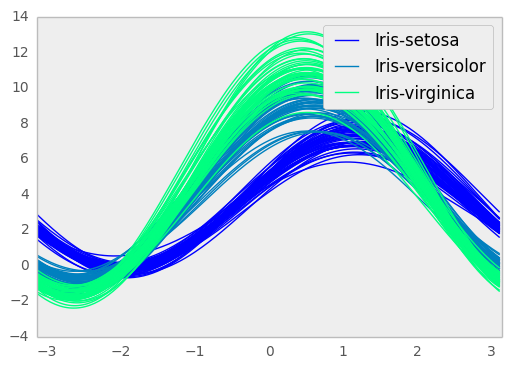
Plotting directly with matplotlib¶
In some situations it may still be preferable or necessary to prepare plots directly with matplotlib, for instance when a certain type of plot or customization is not (yet) supported by pandas. Series and DataFrame objects behave like arrays and can therefore be passed directly to matplotlib functions without explicit casts.
pandas also automatically registers formatters and locators that recognize date indices, thereby extending date and time support to practically all plot types available in matplotlib. Although this formatting does not provide the same level of refinement you would get when plotting via pandas, it can be faster when plotting a large number of points.
Note
The speed up for large data sets only applies to pandas 0.14.0 and later.
In [153]: price = Series(randn(150).cumsum(),
.....: index=date_range('2000-1-1', periods=150, freq='B'))
.....:
In [154]: ma = pd.rolling_mean(price, 20)
In [155]: mstd = pd.rolling_std(price, 20)
In [156]: plt.figure()
Out[156]: <matplotlib.figure.Figure at 0x9dab2b4c>
In [157]: plt.plot(price.index, price, 'k')
Out[157]: [<matplotlib.lines.Line2D at 0x9d98e9cc>]
In [158]: plt.plot(ma.index, ma, 'b')
Out[158]: [<matplotlib.lines.Line2D at 0x9e7aa40c>]
In [159]: plt.fill_between(mstd.index, ma-2*mstd, ma+2*mstd, color='b', alpha=0.2)
Out[159]: <matplotlib.collections.PolyCollection at 0x9d92ea4c>
